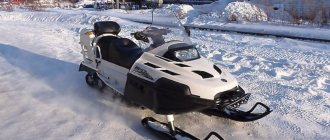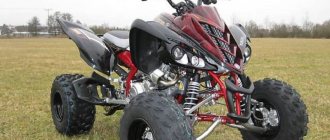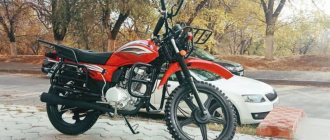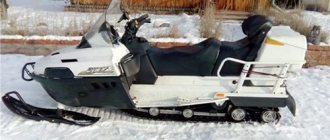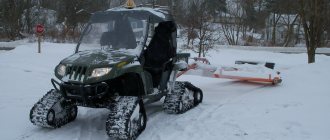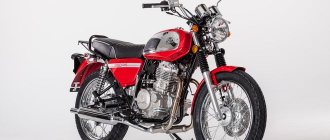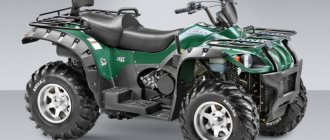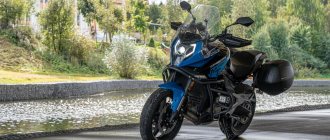BRP Links Yeti Pro Army 800 is a Canadian ultra-modern snowmobile, which is distinguished by reliability, fuel efficiency, high build quality, dynamism and interesting design. The BRP Lynx Yeti Pro Army V 800 was originally designed for the army, but now anyone can buy this powerful machine. “Army Man” is even chosen by athletes who practice extreme racing on snowy off-road terrain. This model from the Super Wide Track class (with an ultra-wide track) is characterized by increased maneuverability and stability.
Hard workers
This device is the undoubted class leader, primarily in terms of price. Bravo - that's its full name - appeared back in 1992 and has been produced almost unchanged since then. His credo is modesty, conciseness and simplicity. A single-cylinder two-stroke air-cooled engine, the simplest suspension (springs and shock absorbers in the front and a spring-loaded slide with a shock absorber in the rear), the absence of electric start and reverse gear, a mechanical drive of the disc brake - everything is aimed at simplifying, lightening and reducing the cost of the car.
In literally all characteristics, except perhaps power, Bravo can be put on a par with products from domestic manufacturers. The only striking difference between the “Japanese” and the “Nasheprom” products is the quality of workmanship and reliability. Even the very first argument of many supporters of domestic products: “But it breaks, so what to do? And “Buran” I can fix in any snowdrift ...” in this case does not work, because the design of the “bateshka” is perhaps even simpler than the same “Lynx” or “Buran”.
The lack of reverse in the transmission is somewhat surprising, but one glance at the figure of the curb weight of the device (and this is only 200 kg) removes the question: if something happens, you can turn it around with the handles. The rather narrow track of the skis and the primitive suspension make energetic driving almost impossible; the device strives to end up “upward with its fins” in any more or less steep turn and even catching a snow bump that seems insignificant at first glance. But even this shortcoming in the framework of a simple utilitarian approach should not be considered as such. If you want to "burn" - if you please, the device is three times more expensive.
Of course, Bravo is far from a record holder in terms of traction and dynamic characteristics. The declared maximum speed is only 70 km/h, and you can’t attach a sled with hundreds of kilograms of luggage - it won’t pull it out. But it’s difficult to find a more suitable car, say, for going fishing or patrolling ranger grounds.
VK540III
Hard workers
Engine: 2-cylinder, in-line, 2-stroke, 535 cm3, 46 hp.
Ski track: 960 mm Track size (LxWxH): 3968 x 508 x 25 mm Dry weight: 291 kg Price**: RUB 283,000 Engine: 2-cylinder, in-line, 2-stroke, 535 cm3, 46 hp. Ski track: 960 mm Track size (LxWxH): 3968 x 508 x 25 mm Dry weight: 291 kg Price**: RUB 283,000
Viking III is perhaps the most balanced “price-quality-comfort” utility from the “three tuning forks”. Unlike the truly spartan BR250T, everything in this device is truly mature, from the engine to the equipment. A two-cylinder engine of more than half a liter capacity produces 46 horsepower, although modest, but quite acceptable for ordinary household tasks, and the variator, in addition to reverse, is also equipped with a reduction range. Plus a wide track with good grip, allowing you to move through snow of any depth with maximum load - all this makes the Viking III an ideal working machine for any task. It can become a multifunctional transport at a ski resort, a shuttle for oil workers in the Arctic, and an excellent assistant for hunters.
In addition to quite acceptable dynamics and towing potential, the Viking III does not shy away from comfort. There is nothing superfluous in it, but it has everything you need for comfortable everyday work for many hours. Of course, there is already electric start, heated steering wheel grips, and a backrest for the passenger. The basic package includes a towbar and a luggage rack. The suspension also contributes to rider comfort: the skis are mounted on telescopic struts, and the ProAction Plus rear suspension with a high-pressure gas-filled shock absorber and the ability to quickly adjust spring preload and rebound damping is generally considered one of the best in the world. In short, the Viking III is a truly universal device: it can not only perform complex work in any weather conditions, but also become an excellent tool for traveling or riding, because for it comfort is not an empty phrase.
Polaris. This American company was one of the first to start selling its equipment in Russia. That is why its snowmobiles are, perhaps, more often than others found in the snowy expanses of our homeland. Both amateurs and professionals appreciated their quality and reliability. According to many experts, it is Polaris that is most suitable for operation in Russian conditions. The reason is not only the reliability and unpretentiousness of the equipment, but also the availability of spare parts, and not only original ones. In neighboring Finland, for example, Polaris snowmobiles are so popular that a whole industry has emerged around them, offering not only all kinds of tuning and accessories, but also a full range of spare parts. This, of course, speeds up and reduces the cost of any repair, since spare parts are much closer to transport. According to the traditional classification, snowmobiles designed for movement in deep snow are called Wide Track; the main feature of this type of equipment is a wide track. Polaris utility vehicles bear exactly this name, but in a slightly modified form.
WIDETRAK LX
Snowmobile brp lynx yeti pro 800
Their main task is not to let you down in the most difficult situation. Our review is dedicated to the simplest, most unpretentious and affordable snowmobiles.
In literally all characteristics, except perhaps power, Bravo can be put on a par with products from domestic manufacturers. The only striking difference between the “Japanese” and the “Nasheprom” products is the quality of workmanship and reliability. Even the very first argument of many supporters of domestic products: “But it breaks, so what to do? And “Buran” I can fix in any snowdrift ...” in this case it does not work, because the design of the “bateshka” is perhaps even simpler than the same “Lynx” or “Buran”.
Of course, Bravo is far from a record holder in terms of traction and dynamic characteristics. The declared maximum speed is only 70 km/h, and you can’t attach a sled with hundreds of kilograms of luggage - it won’t pull it out. But it’s difficult to find a more suitable car, say, for going fishing or patrolling ranger grounds.
Viking III is perhaps the most balanced “price-quality-comfort” utility from the “three tuning forks”. Unlike the truly spartan BR250T, everything in this device is truly mature, from the engine to the equipment. A two-cylinder engine of more than half a liter capacity produces 46 horsepower, although modest, but quite acceptable for ordinary household tasks, and the variator, in addition to reverse, is also equipped with a reduction range. Plus a wide track with good grip, allowing you to move through snow of any depth with maximum load - all this makes the Viking III an ideal working machine for any task. It can become a multifunctional transport at a ski resort, a shuttle for oil workers in the Arctic, and an excellent assistant for hunters.
Polaris. This American company was one of the first to start selling its equipment in Russia. That is why its snowmobiles are, perhaps, more often than others found in the snowy expanses of our homeland. Both amateurs and professionals appreciated their quality and reliability. According to many experts, it is Polaris that is most suitable for operation in Russian conditions. The reason is not only the reliability and unpretentiousness of the equipment, but also the availability of spare parts, and not only original ones. In neighboring Finland, for example, Polaris snowmobiles are so popular that a whole industry has emerged around them, offering not only all kinds of tuning and accessories, but also a full range of spare parts. This, of course, speeds up and reduces the cost of any repair, since spare parts are much closer to transport. According to the traditional classification, snowmobiles designed for movement in deep snow are called Wide Track; the main feature of this type of equipment is a wide track. Polaris utility vehicles bear exactly this name, but in a slightly modified form.
This model is the most affordable in the company's line of utilitarian snowmobiles. But, unlike Yamaha, the “American” does not at all pretend to be a “gray mouse”, both externally and internally. The peculiarities of the national character are reflected. After all, Americans manage to make even such prosaic things as long-distance trucks and tractors beautiful - just remember Mack tractors. The picture is the same with snowmobiles: Widetrak LX, although the youngest, looks very daredevil. It is immediately clear that not only layout engineers, but also designers worked on the appearance of the car. Although this is not the main advantage of a utilitarian car, it is still nice. As for the main thing, everything is in perfect order here with Polaris: with an engine displacement that is 50 cm3 smaller than that of the Yamaha Viking III, the power of the “American” is almost twice as high - 85 hp. First of all, this is achieved by installing a separate carburetor for each cylinder. Due to the large power supply, the engine was also equipped with a liquid cooling system. For the same reason, a mechanical brake is no longer enough here - it is hydraulic.
Match the engine and suspension. The Americans did not skimp on comfort: the skis are mounted on a modern IFS lever suspension, and the rear adjustable suspension with articulated extension has two shock absorbers - front and rear. Of course, the Yankees did not forget about the much-needed “utilities”, such as a lattice trunk at the rear, a large underseat space for luggage and a towbar. The passenger seat is equipped with an adjustable backrest, and the steering wheel handles and gas trigger are heated. The basic package even includes a 12 V socket.
BRP-Lynx
Yeti Pro 550
The Finn is equipped with a two-cylinder two-stroke Rotax engine (another greeting from BRP) paired with a variator equipped with a Syncro system, which softens transmission jerks when starting off, even if there is a very heavy trailer behind it.
“Bigfoot” also has a brother, produced on the same Yeti II platform, the Yeti Pro Army V-800 four-stroke. Externally, the cars are almost indistinguishable, but under the hood of the Army Man there is a completely different filling hidden - a Rotax V-810 engine, designed specifically for snowmobiles. The impressive displacement and settings, focused more on traction than on power, allow the snowmobile not only to easily drag sleds with “killed bears”, but also to pull cars and small SUVs out of snow captivity.
*Prices in Moscow at the beginning of October 2009.
REVIEWS ABOUT THE YETI PRO ARMY V800 SNOWMOBILE
20 cm of snow fell and I decided to start breaking in the snowmobile. I rode for 2 days. Traveled 100 km. The air temperature was −3, −5. Burned 20 liters of gasoline. Impression. The sound of the engine at idle is lovely. The sound of the engine at low speed is significantly quieter than the 2T. It was snowing. Moving slowly, 20 km per hour, several times a day I raised sleeping goats at 20 meters. But when driving at a speed of more than 40 km/h, the engine sound resembles a K700 or a turbodiesel without a muffler. In addition, some vibration appears. Is this how it should be? I have not overclocked it to more than 60 yet. Still, there is not enough snow, but at 40 it breaks the goose into slipping. The honeycombs for supplying air to the cooling radiator under the hood become clogged with snow. The electric cooling fan turns on very often. What's wrong with the temperature? It's cold, but the overheating light didn't light up. The temperature indicator will have to be installed separately. It steers very well, but it's hard. At the end of the trip, my arms get very tired. For such a weight, the standard handles seemed small in diameter, although 2T was enough for the Army. I'm thinking of making it thicker. I really liked the low end traction. For this I am ready to forgive the apparatus its HELLO weight. I appreciated the opportunity to move off smoothly, with tension, without slipping, when moving over fallen trees and leaving unfrozen streams, where I managed to fall a couple of times. Knocked it over twice. Once in a field on a hummock, and the second time in a rut. Both times I was able to lift it myself within 5 minutes. But I almost tore my butt. You should at least buy a hand winch. Driving without a winch seems like an adventurism. Very comfortable fit. The trunk is just a dream. And a chainsaw gets in and a sack with an unbutchered goat (I don’t like doing this in the field) and much, much more. So far I am very pleased with the device!!!
Denis, Novosibirsk
Today I also went out to test my Yeti Pro V-800 for the first time. I started quietly, 20-30 km. My wife is in the back seat. Snow 15-20 cm. Sitting along the field along the forest, we arrived at the place where barbecue was being prepared. The weather is whispering, there is snow without wind... I have caught God by the beard!!! While the barbecue was being prepared, I took the gun, twirled it for a long time, where to place it (I’m not a great hunter, so, for bottles, occasionally for ducks, capercaillie, braids, four-legged animals, my hand doesn’t rise, and I don’t really need it anyway). The best thing is that it’s there and it’s like I’m going to get some prey on business. I hung it on my chest, I couldn’t think of a better one. I drove off for half a kilometer, a small slope with rare bumps began, the speed was 10-15 km. It seemed like he was coaxing, but he didn’t get impudent. Then, suddenly, I’m flying... With a gun, it’s a pity there was no one nearby, take a photo. Snezhik is working, he didn’t fasten the cap. While I was floundering, half a minute passed before I turned it off. Although I trained, I memorized the sequence of actions in such a situation. Well, I think, p..t., we need to shoot so that our friends ride on Buran to the rescue. What if they think that I’m fucking with the scythes? On the forum in my brain, I’ll pick up one dick. The winch is in the trunk, in the bag. I forgot about her. And there were no trees nearby. In short, out of fright, he raised it three times with an interception. I think the freak ruined the new device. I examined it, everything seems to be intact. I started it up and put the gun in the trunk. As I felt, I drove off and after about 40 meters I fell onto my right side again. Yes, this time I fastened the pin, but the engine is running again, and the pin is in place. Vomited in the wrong place. I turned it off more confidently, shook it and, using the reverse force of inertia, picked it up right away. I started it, but it kept squeaking and complaining about a malfunction, but it didn’t gain any momentum. Well, I think I’ve completely ruined it now. It was a good book, I found the problem, blah, I started to respect myself. When I was flying, and I was still pushing off the snowball in flight so as not to crush it, even though the plug remained in place, apparently I pulled well, the contact was broken. I pushed it into place more tightly and everything worked. Didn't fall again, but disappointed. So much for SWT, but what if my wife were traveling with me? I drove off the slope and drove straight back. After cooling down, I rode around the field for two hours, accelerating to 70 km, not at full throttle. I also noticed the noise after 30-40 km. This is my first snowflake, in the team of 3 Buranas, compared to them it’s quieter of course, but I expected more. They only took me around on Buran; I couldn’t cope with its helmsman. I tried it a couple of times and spat in the sled or in the back. Compared to him, of course it’s better. I’m starting to realize one of the catchphrases of the forum: “The gasket rules!” Will learn…
Yuri, Krasnoyarsk region, Achinsk
Easy easy, don't even be puzzled. When the equipment is stationary or stuck, it is heavy and unliftable, but while driving it balances easily..... Just don’t stupidly sit backwards where balancing is required, if you think it’s a windtruck, then you can sit in a car and drive, no Of course we have to work. Or are you going to convince me that on a completely flat surface he just turned over? Having understood the behavior, previously, under the terrain and inertia, use your hands on the steering wheel to correctly drive it, tilt it, and push it if necessary, you can believe me that while driving, this is all done easily, you just need to feel the balance and ride on it, but anything falls and overturns. If you notice that the terrain is like this, and the snowmobile moves only if it transmits traction correctly with the propulsion system. Riding a snowmobile is moving from point a to point b, but provided that the mechanism has a conditionally horizontal position anywhere (with the exception of driving on slopes or along) A sufficient supply of inertia and speed is required there so that sufficient forward movement remains (this is also a balance, you need to feel it too) And if the forward movement is lost, you need to jerk the snowmobile around with its nose down, you’ve passed the critical moment of loss of movement and you’re digging. When you go uphill at the limit, the track must be unloaded as much as possible by rocking and pulling to the sides, including the utilitarian snowmobile. This is also a balance of swinging, throttling and maneuvering on a slope, he needs to learn to feel it, it’s not easy to describe it. A simple example is a plain, you approach a hill. The first thing is to try (especially on a windtruck) to drive onto the slope at right angles to the plane of the slope. Then the track will have sufficient support to form good traction. Make sure that the entry is quite smooth, otherwise you will stick your skis and yourself into the steering wheel, if not, look for another place or enter at an angle, balancing on one ski, pointing (hanging) the snowmobile into the inside of the slope with the throttle, cutting off the track area conditionally parallel to the plane of the earth. Therefore, when you look at the territory, you almost always have to draw a path in your head in advance, but it is drawn with experience, approximately whether you can drive there or not, and if you don’t enter, then you know in advance where you will turn, as if you model it in advance. At the same time, when you are going up a hill or in loose snow, you should always know the escape route, just sawing and digging you will travel no more than a kilometer in a day, but up the hill you just need to turn around and do it again, dig there and move to the top, perhaps on a mountain climber or not all slopes. And at the same time, you need to understand the snow, feel its load-bearing capacity, and at the first signs of getting stuck and getting stuck, look for or make a loop to get onto the track or crust, etc. Riding a snowmobile is not a smile on your face from speed and drink. This is normal active physical labor as a derivative of analytics and modeling of mechanism behavior in a constantly changing environment. And also so that they would understand what I’m talking about. A snowmobile weighs 250 kg, conventionally, a person in a package, conventionally 100, two conventionally 200. What am I talking about? The fact that even in the first case, the mass of a person is a determining and influencing factor in the behavior (or rather, in a constant horizontal position) of a snowmobile. What can we say when there are two riders. This is all conditional, of course, but the general principles are still clear: you can’t sit while turning (on a rolled one) or sink it inside on powder, because with your inertia and your mass, you will eventually turn it over. And if you say that we are hanging and training, I will simply tell you what that means is not enough for this situation (speed, radius and load-bearing capacity of the snow). This is just the amount of experience and momentum. In some places you have to get off of him, push him behind the wheel if he’s driving alone and get in with you, in some places you have to drive slowly, slowly, standing with one foot on the shock absorber joint of the front suspension, heaving and tilting in order to make your way along some kind of ravine or washout, and there’s not enough room for a high-speed maneuver and... and acceleration to the horizontal exit predicted for the next start. There are a lot of nuances here. And the V800 is a really light and controllable snowmobile, but like all snowmobiles it has its own individual qualities, they need to be felt and riding is possible only by tracking the balance of these qualities.
Yeti Pro Army V-800 snowmobiles are discussed here
Buy Lynx Yeti Pro Army V-800 snowmobile
Sources
- https://www.zr.ru/content/articles/121527-trudagi_snegohody_2010/
- https://www.snow-mobiles.ru/lynx/otziv-yeti-pro-army-v800.shtml
Hard workers
WIDETRAK LX Engine: 2-cylinder, in-line, 2-stroke, 488 cm3, 85 hp.
Ski track: 965 mm Track size (LxWxH): 3962 x 508 x 25 mm Dry weight: 278 kg Price**: RUB 313,000 WIDETRAK LX Engine: 2-cylinder, in-line, 2-stroke, 488 cm3, 85 hp. Ski track: 965 mm Track size (LxWxH): 3962 x 508 x 25 mm Dry weight: 278 kg Price**: RUB 313,000
This model is the most affordable in the company's line of utilitarian snowmobiles. But, unlike Yamaha, the “American” does not at all pretend to be a “gray mouse”, both externally and internally. The peculiarities of the national character are reflected. After all, Americans manage to make even such prosaic things as long-distance trucks and tractors beautiful - just remember Mack tractors. The picture is the same with snowmobiles: Widetrak LX, although the youngest, looks very daredevil. It is immediately clear that not only layout engineers, but also designers worked on the appearance of the car. Although this is not the main advantage of a utilitarian car, it is still nice. As for the main thing, everything is in perfect order here with Polaris: with an engine displacement that is 50 cm3 smaller than that of the Yamaha Viking III, the power of the “American” is almost twice as high - 85 hp. First of all, this is achieved by installing a separate carburetor for each cylinder. Due to the large power supply, the engine was also equipped with a liquid cooling system. For the same reason, a mechanical brake is no longer enough here - it is hydraulic.
The CVT transmission is equipped with reverse and a reduction range, which significantly expands the possibilities of both movement in difficult conditions and transportation of loaded sleds. This is where the Widetrak LX and Viking III are twin brothers. And their “shoes” are practically the same size: the width of the caterpillar “half a meter” allows you to move through snowdrifts of any depth. And thanks to its power, the LX is even capable of pulling a car out of a ditch, something the “Japanese brother” can hardly boast of.
Match the engine and suspension. The Americans did not skimp on comfort: the skis are mounted on a modern IFS lever suspension, and the rear adjustable suspension with articulated extension has two shock absorbers - front and rear. Of course, the Yankees did not forget about the much-needed “utilities”, such as a lattice trunk at the rear, a large underseat space for luggage and a towbar. The passenger seat is equipped with an adjustable backrest, and the steering wheel handles and gas trigger are heated. The basic package even includes a 12 V socket.
In a word, this device can already be considered fully universal. Even if you go into the forest for firewood, even if you drag a dead bear on a sleigh, or if you want to take the girls around the dacha with the wind, and even your snowmobile friends won’t shy away from you.
BRP-Lynx
The once Finnish brand Lynx, although a fairly old player in the snowmobile market (the first snowmobile under this brand was released in 1968), until recently was in approximately the same “health” as domestic manufacturers. Morally and technically outdated models, appalling build quality... the flow of complaint equipment entering the factory gates was not much less than the flow coming off the assembly line. The situation changed dramatically when the brand, with all its production and engineering innards, was bought by the BRP concern. Effective quality control and highly qualified management have raised the brand to a new level. Now Lynx snowmobiles meet the best world standards. True, the brand is focused mainly on the domestic market of Finland, and although official BRP dealers operate in Russia, selling, of course, Finnish equipment, its share in our market is small.
Yeti Pro 550
The machines are equipped with innovative design features:
- Electronic direct fuel injection system E-TEC;
- A-shaped wishbone suspension.
- Gearbox with two speeds.
- Hydraulic brake mechanism, increased reliability;
- Comfortable ergonomic seats;
- Digital information display, multifunctional type.
- The model range includes single and double cars, with windproof windows installed. For added comfort in harsh winter conditions, the snowmobiles are equipped with comfortable footrests and heated handlebar grips.
Hard workers
Yeti Pro 550 Engine: 2-cylinder, in-line, 2-stroke, 553 cm3, 57 hp.
Ski track: 900 mm Track size (LxWxH): 3968 x 600 x 32 mm Dry weight: 295 kg Price**: RUB 399,000 Yeti Pro 550 Engine: 2-cylinder, in-line, 2-stroke, 553 cm3, 57 hp. Ski track: 900 mm Track size (LxWxH): 3968 x 600 x 32 mm Dry weight: 295 kg Price**: RUB 399,000
This device belongs to the Super Wide Track category, that is, with an ultra-wide track. Hence the name - “Yeti”, also known as “Bigfoot”. These are a kind of all-terrain vehicles of the highest category of cross-country ability. Matching the width and height of the lugs is 32 mm. With such weapons, you can safely climb into any of the most impassable snowdrifts and wet slush, not only “empty”, but also with a weighty trailer on the tail. By the way, this “Bigfoot” is equipped with a modular seat with a quick-release passenger part. Having thrown off the “half-sofa” in the garage, we get a trunk that is quite large by the standards of the class. Of course, the tow bar is included.
The Finn is equipped with a two-cylinder two-stroke Rotax engine (another greeting from BRP) paired with a variator equipped with a Syncro system, which softens transmission jerks when starting off, even if there is a very heavy trailer behind it.
YETI Pro Army V-800
Hard workers
Yeti Pro Army V-800 Engine: 2-cylinder, V-shaped, 4-stroke, 800 cm3, 65 hp.
Ski track: 900 mm Track size (LxWxH): 3968 x 600 x 32 mm Dry weight: 320 kg Price**: RUB 559,000 Yeti Pro Army V-800 Engine: 2-cylinder, V-shaped, 4-stroke, 800 cm3, 65 hp. Ski track: 900 mm Track size (LxWxH): 3968 x 600 x 32 mm Dry weight: 320 kg Price**: RUB 559,000
“Bigfoot” also has a brother, produced on the same Yeti II platform, the Yeti Pro Army V-800 four-stroke. Externally, the cars are almost indistinguishable, but under the hood of the Army Man there is a completely different filling hidden - a Rotax V-810 engine, designed specifically for snowmobiles. The impressive displacement and settings, focused more on traction than on power, allow the snowmobile not only to easily drag sleds with “killed bears”, but also to pull cars and small SUVs out of snow captivity.
Pro Army was truly conceived as a device for the most difficult operating conditions. And it is not just words. In addition to the usual low-range transmission, heated grips, high windshield, rack and towbar for snowmobiles in this class, a spare variator belt and a set of spark plugs are standard equipment. And hidden in the depths of the car are two batteries that can ensure reliable starting even in the most severe frosts. The radiators of the cooling system duplicate each other: one is located in the engine compartment and operates at high speeds, cooled by the flow of incoming air, and the second is installed above the track and takes on the main load when the speed is low and a lot of snow flies from the track, for example when towing a heavy load in deep virgin soil. In addition, the standard equipment includes an axe, a knife, a sealed bag for documents and maps, a set of spare lamps and a tow rope, and a sealed trunk is installed on the usual grille trunk for this type of vehicle. In short, the Yeti Pro Army V-800 is perhaps the most packaged device in its class.
*Prices in Moscow at the beginning of October 2009.
Workers: Snowmobiles 2010
Engine
- Engine – petrol, 4-stroke, V-shaped
- Engine brand – Rotax V-810
- Camshaft location - top
- Working volume, power – 800 cubic meters. see 65 horsepower
- Compression ratio 10.3:1
- Cylinder diameter – 91 mm
- Liquid cooling – yes
ICE Features:
- Type of cooling system – liquid
- Lubrication - wet sump
- Oil filter – BRP Rotax replacement paper filter
- Air filter – foam rubber and paper (synthetic)
- Valves, pcs. - 8.
Innovative features of the Rotax V-810 internal combustion engine:
- Long block - technology that has improved the design and strength of the camshaft chain
- The chain tensioner guide is made of high-strength materials. In addition to the high-strength alloy, the steel is coated with rubber. This coating prevents deformation when heated. Thanks to this, it was possible to reduce the stretching of the timing chain, and this had a beneficial effect on reliability and uninterrupted operation. Please note that the guide is installed on the chain tensioner side.
- The fuel tank holds 42 liters and the oil tank capacity is 2.8 liters.
